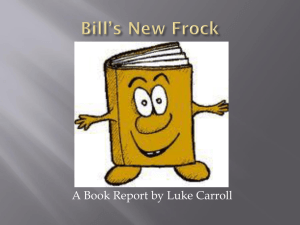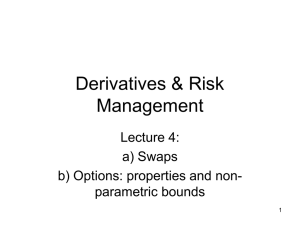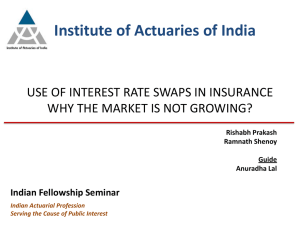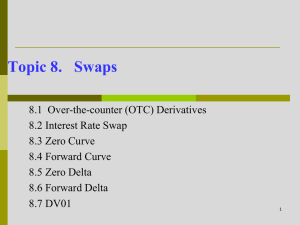Currency & Interest Rate Swaps
advertisement
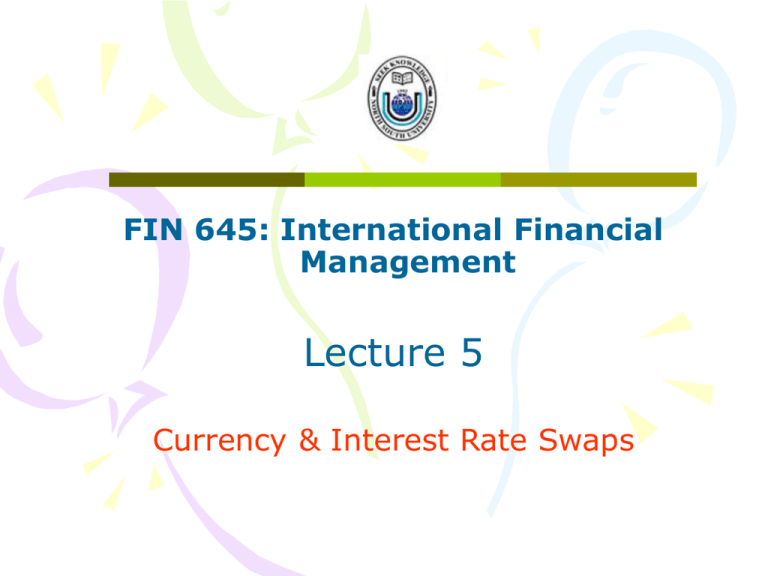
FIN 645: International Financial Management Lecture 5 Currency & Interest Rate Swaps Lecture Outline • Types of Swaps • Size of the Swap Market • The Swap Bank • Interest Rate Swaps • Currency Swaps Lecture Outline (continued) • Swap Market Quotations • Variations of Basic Currency and Interest Rate Swaps • Risks of Interest Rate and Currency Swaps • Swap Market Efficiency • Concluding Points About Swaps Definitions • In a swap, two counterparties agree to a contractual arrangement wherein they agree to exchange cash flows at periodic intervals. • There are two types of interest rate swaps: – Single currency interest rate swap • “Plain vanilla” fixed-for-floating swaps are often just called interest rate swaps. – Cross-Currency interest rate swap • This is often called a currency swap; fixed for fixed rate debt service in two (or more) currencies. Size of the Swap Market • In 2007, the total amount of interest rate swaps outstanding was $ 271.9 trillion($36,262 billion in 1998) and outstanding Currency swaps$12 trillion($2253 billion in 1998) • The most popular currencies are: – – – – U.S.$ (34%) ¥ (23%) € (21%) £ (6%) The Swap Bank • A swap bank is a generic term to describe a financial institution that facilitates swaps between counterparties. • The swap bank can serve as either a broker or a dealer. – As a broker, the swap bank matches counterparties but does not assume any of the risks of the swap. – As a dealer, the swap bank stands ready to accept either side of a currency swap, and then later lay off their risk, or match it with a counterparty. Interest Rate Swap in Project Finance Transactions – – – – – – – – – Definition of Project Finance Three Approaches to Structured Finance Types of Interest Rate What is Interest Rate Risk? What is Interest Rate Swap? Types of Swaps Advantages of Swap Pricing of an Interest Rate Swap Other Derivatives Used in Project Finance Transactions Interest Rate Swap in Project Finance Transactions Definition of Project Finance “The raising of funds to finance a standalone capital intensive project in which the providers of the funds look primarily to the cash flow from the project as the source of (a) repayment of their loans, and (b) return on their equity invested in the project” Interest Rate Swap in Project Finance Transactions Three Approaches to Structured Finance Structured Finance Project Finance Acquisition Finance Securitization Interest Rate Swap in Project Finance Transactions Types of Interest Rate • • Fixed rate – 10% on a 5-year bond Floating/variable rate – LIBOR, certificate of deposit, repo rate, average weighted deposit rate (AWDR) of scheduled banks, call money rate, etc. What is Interest Rate Risk? • The uncertainty that over the life of the loan, interest rate may move adversely, thereby, causing a huge interest burden for the project Interest Rate Swap in Project Finance Transactions Interest Rate Swap in Project Finance Transactions Interest Rate Swap in Project Finance Transactions Important Concepts • Notional principal (the amount used as the basis for computations of net payments to be made by swap counter parties) • Tenor and payment dates • Fixed leg • Variable leg • Day counting convention • Payment netting • Counter party: buyer and seller Interest Rate Swap in Project Finance Transactions Day Counting Conventions Number of days between two payment dates Number of days in a year X Annual interest rate X Notional principal 3 types of day counting conventions are: actual/365 actual/360 30/360 Interest Rate Swap in Project Finance Transactions Payment Netting It is a market convention that the exchange of interest payments between two parties is executed through payment netting. If fixed rate is lower than floating rate,the residual goes to fixed rate payer. Floating Rate Fixed Rate If the fixed rate is higher than the floating rate ,the res idual goes to fl oating r ate payer. Interest Rate Swap in Project Finance Transactions Basic Structure BA: fixed interest rate Party “A" $ 150 million loan Fixed Interes t Rate Bank AB: variable interest rate Swap would be based on notional principal of $100 million Party “B" $ 100 million loan Variable Interest Rate Bank Interest Rate Swap in Project Finance Transactions An Example • Party A agrees to pay 8.75% on $100 million to Party B. Party B agrees to make floating rate payments to Party A in return. However, the actual payment will vary with LIBOR. Year LIBOR Party B Pays Party A (Floating Rate) Party A Pays Party B (Fixed Rate) 0 8.5% 1 LIBOR1 = ? LIBOR0 X 1,000,000 =0.085 X 100,000,000 =8,500,000 8,750,000 2 LIBOR2 = ? LIBOR1 X 100,000,000 875,0000 3 LIBOR3 = ? LIBOR2 X 100,000,000 875,0000 4 LIBOR4 = ? LIBOR3 X 100,000,000 8750000 5 N/A LIBOR4 X 100,000,000 8750000 Net payment made is $250,000 Interest Rate Swap in Project Finance Transactions Types of Swaps – – – – – Plain vanilla swaps, Amortizing swaps, Accreting swaps, Roller coaster swaps, Basis rate swaps, etc. Interest Rate Swap in Project Finance Transactions Types of Swaps: Plain vanilla swaps – – – – – – Floating and fixed payments are regular, e.g. every six months Term of the swap is a whole number of years, e.g. 1, 2, 3, 10 years One party makes fixed rate payments, the other variable rate payments Notional principal remains constant throughout the life of the swaps The fixed rate remains constant throughout the life of the swaps Suitable for loans with Principal repayment at the end of loan life Interest Rate Swap in Project Finance Transactions Types of Swaps: Accreting swaps Used when notional principal increases over time Typical during the construction period Principal Outstanding • • 25 20 15 10 5 0 1st Semi 2nd Semi 3rd Semi 4th Semi 5th Semi Construction Period 6th Semi Interest Rate Swap in Project Finance Transactions Types of Swaps: Amortizing swaps • Used when a loan has scheduled repayments of principal over its term, rather than a bullet repayment structure Notional principal decreases over time Principal Outstanding • 25 20 15 10 5 0 1st Semi 2nd Semi 3rd Semi 4th Semi 5th Semi Repayment Period 6th Semi Interest Rate Swap in Project Finance Transactions Types of Swaps: Roller coaster swaps • Accommodates the characteristics of both amortizing and accreting swaps Typical for large infrastructure projects Principal Outstanding • 25 20 15 10 5 0 1st Semi 2nd Semi 3rd Semi Construction Period 4th Semi 5th Semi 6th Semi Repayment Period Interest Rate Swap in Project Finance Transactions Types of Swaps: Other swaps Seasonal swap: An interest rate swap in which the principal alternates between zero and the notional amount (which can change or stay constant). The principal amount of the swap is designed to hedge the seasonal borrowing needs of a company. Off-market swap: In this type of swap, a premium is built into the swap price to fund the purchase of options or to allow for the restructuring of a hedge portfolio. Offmarket swaps are generally used to restructure or cancel old swap/hedge deals: essentially, they simulate a refinancing pack-age Interest Rate Swap in Project Finance Transactions Advantages of Swaps • • • • • • • • • Theory of comparative advantage applies i.e. entity should borrow at a rate (fixed/floating) in which it has a comparative advantage. Suppose X and Y are two companies. X’s borrowing situations (in fixed and floating rate) are as follows: Bank (Floating) Bond (Fixed) LIBOR + 0.35% UST+0.70% Y’s borrowing situations (in fixed and floating rate) are as follows: Bank (Floating) Bond (Fixed) LIBOR + 1.5% UST+3.50% X has absolute advantage on both bank (floating) and bond (fixed) loans. However, Y has comparative advantage on bank (floating) loans. Note this, for bank loan credit/quality spread of X vs. Y is 1.15%; while for bond it is 2.8%. Hence, Y should borrow at floating rate (from Bank) while X should at fixed rate (from bond market) and swap among themselves and collectively realize total savings of 1.65% (2.8% minus 1.15%), known as quality spread differential. However, how this 1.65% will be shared depends on relative bargaining power. In the illustration that follows, we see that X keeps 1.45% while Y retains 0.2%. Interest Rate Swap in Project Finance Transactions Advantages of Swaps…cont’d • Assuming LIBOR and UST are 6% and 8.5% respectively, X Y Bank (Floating) 7.5%(6% + 1.5%) Bond (Fixed) 9.2% (8.5% + 0.7%) Assuming X & Y enter into a swap for a fixed rate of 10.3% (Y pays fixed rate to X in exchange of LIBOR). • Position of X, therefore is as follows: Pays fixed rate on bond 9.2% p.a. Receives from Y (10.3%) Pays LIBOR to Y 6.0% Total payments 4.9% p.a. Please note it is less than 1.45% of floating rate of LIBOR+0.35%. • Position of Y, therefore is as follows: Pays variable rate on bank loan 7.5% p.a. Receives from X (6.0%) Pays fixed rate to X 10.3% Total payments 11.8% p.a. Please note it is less than 0.2% of fixed rate of UST+3.5%. The QSD • The Quality Spread Differential represents the potential gains from the swap that can be shared between the counterparties and the swap bank. • There is no reason to presume that the gains will be shared equally. • Less credit-worthy entity will probably would have gotten less of the QSD, in order to compensate the swap bank for the default risk. Interest Rate Swap in Project Finance Transactions Floating Leg PV of Floating Leg = $20 mill Floating Leg PV of Floating Leg = $20 mill Floating Leg PV of Floating Leg = $20 mill Pricing of Swaps…cont’d. g > g < PV of Fixed Leg = $18 mill PV of Fixed Leg = $22 mill 7% 7% 7% 7% Fixed Leg 9% 9% 9% 9% Fixed Leg Price of the Swap = PV of Fixed Leg = $20 mill 8% 8% 8% Fixed Leg 8% Interest Rate Swap in Project Finance Transactions Pricing of Swaps Illustration: A $105 million roller coaster swap Loan amount: $105 million variable-rate loan. Tenor: 5 years. Grace period: 21/2 years. Construction period: 2 years; during when interest on loan is rolled up and capitalized. Loan drawdown: 4 equal semi-annual drawdowns; first one commencing at financial closing; while the rest three while facility is being constructed. Repayment profile: 6 level principal; semi-annual. Repayment starts: First repayment commences on six months after construction completion. Problem: Find an equivalent fixed rate based on the same notional principal with same drawdown profile. Interest Rate Swap in Project Finance Transactions Pricing of Swaps…cont’d. • Swap Pricing [Shows Calculations] Interest Rate Swap in Project Finance Transactions Other Derivatives Used in Project Finance Transactions – – – Interest rate cap Interest rate floor Interest rate collar Interest Rate Swap in Project Finance Transactions Interest Rate Cap • An interest-rate cap is a derivative that protects the holder from rises in short-term interest rates by making a payment to the holder when an underlying interest rate (the "index" or "reference" interest rate) exceeds a specified strike rate (the "cap rate"). • Caps are purchased for a premium and typically have expirations between 1 and 7 years. They may make payments to the holder on a monthly, quarterly or semiannual basis, with the period generally set equal to the maturity of the index interest rate. • Each period, the payment is determined by comparing the current level of the index interest rate with the cap rate. If the index rate exceeds the cap rate, the payment is based upon the difference between the two rates, the length of the period, and the contract's notional amount. Otherwise, no payment is made for that period. If a payment is due on a USD Libor cap, it is calculated as Class Exercise • Payments made under a hypothetical interest rate scenario by a 3-year USD 200MM notional cap linked to 6month USD Libor with strike rate of 7.5%. Values for the index rate are 6.25%, 7.75%, 7.00%, 8.50%, 8.00%, and 6.25%. Interest Rate Swap in Project Finance Transactions Interest Rate Cap…an example For example, a 3-year, USD 200MM notional cap with 6-month Libor as its index rate, struck at 7.5%. The exhibit shows what the cap's payments would be under a hypothetical interest rate scenario. Payments made under a hypothetical interest rate scenario by a 3-year USD 200MM notional cap linked to 6-month USD Libor with strike rate of 7.5%. Values for the index rate are 6.25%, 7.75%, 7.00%, 8.50%, 8.00%, and 6.25%. These result in payments of USD 0MM, USD .25MM, USD 0MM, USD 1MM, USD .5MM, and USD 0MM. Interest Rate Swap in Project Finance Transactions Interest Rate Floor • Interest rate floors compare to interest rate caps are derivatives that protect the holder from declines in short-term interest rates by making a payment to the holder when an underlying interest rate (the "index" or "reference" interest rate) falls below a specified strike rate (the "floor rate"). • Floors are purchased for a premium and typically have maturities between 1 and 7 years. They may make payments to the holder on a monthly, quarterly or semiannual basis, with the period generally set equal to the maturity of the index interest rate. • Each period, the payment is determined by comparing the current level of the index interest rate with the floor rate. If the index rate is below the floor rate, the payment is based upon the difference between the two rates, the length of the period, and the contract's notional amount. Otherwise, no payment is made for that period. In US markets, if a payment is due on a USD Libor floor, it is calculated as An Example of a Currency Swap • Suppose a U.S. MNC wants to finance expansion of its German Subsidiary, the cost is € 40,000,000 • Current exchange rate is $0.90/€1, • The MNC could borrow $36,000,000 in the U.S. where they are well known and exchange for dollars for Euro. – By issuing 5-year bonds at 8% – This will give them exchange rate risk: financing a Euro project with dollars. An Example of a Currency Swap • They could borrow € 40,000,000 in the international bond market, but pay a lot since they are not as well known abroad. – The US firm could borrow 5-year fixed interest rate of 7 percent; The current normal borrowing rate for a well-known firm of equivalent credit worthiness is 6 percent. • A German MNC of equivalent creditworthiness has a US subsidiary in need of $36,000,000 to finance capital expenditure with an economic life of five years. An Example of a Currency Swap • The German parent could raise € 40,000,000 at a fixed interest rate of 6 percent and convert the fund into US dollars to finance the expenditure. – Transaction exposure is created. If Euro appreciates the US subsidiary might have difficulty to meet the debt service. • The German parent could also issue Eurodollar bonds (or Yankee bond in the US capital market), say at a fixed rate of 9 percent, as it is not well known. • A swap bank could arrange a currency swap, instruct each parent firm to raise funds in its national capital market. Then the principal would be exchanged through the swap bank. An Example of a Currency Swap • Annually, the German subsidiary would remit to its US parent € 2,400,000 in interest(6 percent of € 40,000,000) to be passed through the swap bank to the German MNC to meet Euro debt Service. • The US subsidiary would remit to its German parent $2,880,000 in interest(8 percent of $ 36,000,000) to be passed through the swap bank to the US MNC to meet dollar debt Service. • At the debt retirement date, the subsidiaries would remit the principal sums to their respective parents through the swap bank to pay off the bond issues in the national capital markets. Benefits of a Currency Swap • At inception, the principal sums are exchanged at the current exchange rate of $0.90/ € 1= $36,000,000/ € 40,000,000. • Each year prior to debt retirement, the swap agreement calls for counterparties to exchange $2,880,000 of interest on US dollar debt for € 2,400,000 of interest on Euro debt; this is a contractual exchange rate of $0.8333/ € 1. • At the maturity date, a final exchange, including the last interest payment and the re-exchange of the principal sum would take place; $38,880,000 for € 42,400,000. The contractual exchange rate at year 5 is thus $0.9170/ € 1. • Clearly, the swap locks in foreign exchange rates for each counterparty to meet its debt service obligations over the term of the swap. US Dollar Euro Currency Swap German capital market@6% ``US capital market @8% 6% 8% US MNC €@6% Swap Bank $@8% $@8% = = Euro-denominated Eurobond market7% €@6% German MNC Original Principal Exchange Debt Service Re-exchange of principal Eurodollar Eurobond market @9% Risks of Interest Rate and Currency Swaps • Interest Rate Risk – Interest rates might move against the swap bank after it has only gotten half of a swap on the books, or if it has an unhedged position. • Basis Risk – If the floating rates of the two counterparties are not pegged to the same index. • Exchange rate Risk – Exchange rate might move against the swap bank. Risks of Interest Rate and Currency Swaps (continued) • Credit Risk – This is the major risk faced by a swap dealer— the risk that a counter party will default on its end of the swap. • Mismatch Risk – It’s hard to find a counterparty that wants to borrow the right amount of money for the right amount of time. • Sovereign Risk – The risk that a country will impose exchange rate restrictions that will interfere with performance on the swap. Swap Market Efficiency • Swaps offer market completeness and that has accounted for their existence and growth. • Swaps assist in tailoring financing to the type desired by a particular borrower. Since not all types of debt instruments are available to all types of borrowers, both counterparties can benefit (as well as the swap dealer) through financing that is more suitable for their asset maturity structures. An Example of a Currency Swap • If they can find a British MNC with a mirror-image financing need they may both benefit from a swap. • If the exchange rate is S0($/£) = $1.60/£, the U.S. firm needs to find a British firm wanting to finance dollar borrowing in the amount of $16,000,000. An Example of a Currency Swap Consider two firms A and B: firm A is a U.S.–based multinational and firm B is a U.K.–based multinational. Both firms wish to finance a project in each other’s country of the same size. Their borrowing opportunities are given in the table below. $ £ Company A 8.0% 11.6% Company B 10.0% 12.0% An Example of a Currency Swap Swap Bank $9.4% $8% £12 % £11% $8% Company A $ £ Company A 8.0% 11.6% Company B 10.0% 12.0% Company £12 % B An Example of a Currency Swap Swap Bank $9.4% $8% £11% Company A A’s net position is to borrow at £11% $8% £12 % $ £ Company A 8.0% 11.6% Company B 10.0% 12.0% A saves £.6% Company £12 % B An Example of a Currency Swap Swap Bank $9.4% $8% £12 % £11% $8% Company A Company £12 % B B’s net position is to borrow at $9.4% $ £ Company A 8.0% 11.6% Company B 10.0% 12.0% B saves $.6% An Example of a Currency Swap The swap bank makes money too: Swap Bank $8% $8% Company A 1.4% of $16 million financed with 1% of £10 million per year for 5 years. £12 £11% % At S0($/£) = $1.60/£, that is a gain of $124,000 per year for 5 years. $ £ Company A Company B $9.4% Company £12 % B The swap bank faces exchange 8.0% 11.6% rate risk, but 10.0% 12.0% maybe they can lay it off in another swap. Comparative Advantage as the Basis for Swaps A is the more credit-worthy of the two firms. A pays 2% less to borrow in dollars than B A pays .4% less to borrow in pounds than B: $ £ Company A 8.0% 11.6% Company B 10.0% 12.0% A has a comparative advantage in borrowing in dollars. B has a comparative advantage in borrowing in pounds. Comparative Advantage as the Basis for Swaps B has a comparative advantage in borrowing in £. B pays 2% more to borrow in dollars than A $ £ Company A 8.0% 11.6% Company B 10.0% 12.0% B pays only .4% more to borrow in pounds than A: Comparative Advantage as the Basis for Swaps A has a comparative advantage in borrowing in dollars. B has a comparative advantage in borrowing in pounds. If they borrow according to their comparative advantage and then swap, there will be gains for both parties. Swap Market Quotations • Swap banks will tailor the terms of interest rate and currency swaps to customers’ needs • They also make a market in “plain vanilla” swaps and provide quotes for these. Since the swap banks are dealers for these swaps, there is a bidask spread. • For example, 6.60 — 6.85 means the swap bank will pay fixed-rate DM payments at 6.60% against receiving dollar LIBOR or it will receive fixed-rate DM payments at 6.85% against receiving dollar LIBOR. Variations of Basic Currency and Interest Rate Swaps • Currency Swaps – – – – fixed for fixed fixed for floating floating for floating amortizing • Interest Rate Swaps – zero-for floating – floating for floating • For a swap to be possible, a QSD must exist. Beyond that, creativity is the only limit. Pricing a Swap • A swap is a derivative security so it can be priced in terms of the underlying assets: • How to: – Plain vanilla fixed for floating swap gets valued just like a bond. – Currency swap gets valued just like a nest of currency futures. Concluding Remarks • The growth of the swap market has been astounding. • Swaps are off-the-books transactions. • Swaps have become an important source of revenue and risk for banks An Example of an Interest Rate Swap • Consider this example of a “plain vanilla” interest rate swap. • Bank A is a AAA-rated international bank located in the U.K. who wishes to raise $10,000,000 to finance floating-rate Eurodollar loans. – Bank A is considering issuing 5-year fixed-rate Eurodollar bonds at 10 percent. – It would make more sense to for the bank to issue floating-rate notes at LIBOR to finance floating-rate Eurodollar loans. An Example of an Interest Rate Swap • Firm B is a BBB-rated U.S. company. It needs $10,000,000 to finance an investment with a five-year economic life. – Firm B is considering issuing 5-year fixed-rate Eurodollar bonds at 11.75 percent. – Alternatively, firm B can raise the money by issuing 5-year FRNs at LIBOR + ½ percent. – Firm B would prefer to borrow at a fixed rate. An Example of an Interest Rate Swap The borrowing opportunities of the two firms are shown in the following table: Fixed rate Floating rate COMPANY B BANK A DIFFERENTIAL 11.75% 10% 1.75% LIBOR + .5% LIBOR .5% QSD = 1.25% An Example of an Interest Rate Swap Swap Bank 10 3/8% LIBOR – 1/8% Bank A Fixed rate Floating rate The swap bank makes this offer to Bank A: You pay LIBOR – 1/8 % per year on $10 million for 5 years and we will pay you 10 3/8% on $10 million for 5 years COMPANY B BANK A DIFFERENTIAL 11.75% 10% 1.75% LIBOR + .5% LIBOR .5% QSD = 1.25% An Example of an Interest Rate Swap ½ % of $10,000,000 = $50,000. That’s quite a cost savings per year for 5 years. 10 3/8% Swap Bank -10 3/8 + 10 + (LIBOR – 1/8) = LIBOR – 1/8% 10% LIBOR – ½ % which is ½ % better than they can borrow floating without a swap. Bank A Fixed rate Floating rate Here’s what’s in it for Bank A: They can borrow externally at 10% fixed and have a net borrowing position of COMPANY B BANK A DIFFERENTIAL 11.75% 10% 1.75% LIBOR + .5% LIBOR .5% QSD = 1.25% An Example of an Interest Rate Swap The swap bank makes this offer to company B: You pay us 10 ½ % per year on $10 million for 5 years and we will pay you LIBOR – ¼ % per year on $10 million for 5 years. Fixed rate Floating rate Swap Bank 10 ½% LIBOR – ¼% Company B COMPANY B BANK A DIFFERENTIAL 11.75% 10% 1.75% LIBOR + .5% LIBOR .5% QSD = 1.25% An Example of an Interest Rate Swap Here’s what’s in it for B: Swap Bank ½ % of $10,000,000 = $50,000 that’s quite a cost savings per year for 5 10 ½% years. They can borrow externally at LIBOR + ½ % LIBOR – ¼% and have a net borrowing position of Company 10½ + (LIBOR + ½ ) - (LIBOR - ¼ ) = 11.25% which is ½ % better than they can borrow floating without a swap. Fixed rate Floating rate B COMPANY B BANK A DIFFERENTIAL 11.75% 10% 1.75% LIBOR + .5% LIBOR .5% QSD = 1.25% LIBOR + ½% An Example of an Interest Rate Swap The swap bank makes money too. 10 3/8 % Bank LIBOR – ¼% LIBOR – 1/8% 10% ¼ % of $10 million = $25,000 per year for 5 years. 10 ½% Swap Bank LIBOR – 1/8 – [LIBOR – ¼ ]= 1/8 A 10 ½ - 10 3/8 = 1/8 A saves ½ % ¼ Fixed rate Floating rate Company COMPANY B BANK A DIFFERENTIAL 11.75% 10% 1.75% LIBOR + .5% LIBOR .5% QSD = 1.25% B LIBOR + ½% B saves ½ % An Example of an Interest Rate Swap The swap bank makes ¼ % 10 3/8 % Swap Bank LIBOR – ¼% LIBOR – 1/8% 10% 10 ½% Company Bank A Note that the total savings ½ + ½ + ¼ = 1.25 % = QSD B saves ½ % A saves ½ % Fixed rate Floating rate B LIBOR + ½% COMPANY B BANK A DIFFERENTIAL 11.75% 10% 1.75% LIBOR + .5% LIBOR .5% QSD = 1.25% Mid1 Answers 1. 2. 3. 4. 5. 6. (a) p72; (b) p101; © p79; (d) p83; (e) p93. Borrow £; buy $ spot; invest $; sell $ forward. forward. For a starting sum of £ 10,000 covered interest arbitrage profit $131.25 or £109.375. pp 474-481; pp 484-489;article on Law and Finance, pp490-492. p126, Annex 5A. Sell Tk. buy ¥; sell ¥ buy £; sell £ buy Tk. For a starting sum of Tk. 100,000 triangular arbitrage profit Tk. 3834.80. pp109-110
